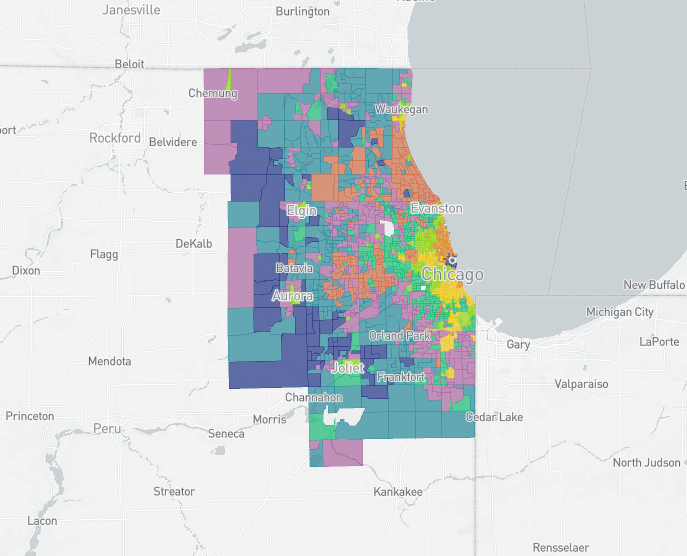The recently launched web-based mapping tool for Regional Housing Solutions allows local government and policymakers to see how a range of housing issues play out across the region, beyond municipal boundaries, and sets the stage for intergovernmental cooperation and advocacy.
Cities across the nation are using data and analysis to understand housing trends and challenges on a more granular level than ever before. Using parcel-level administrative data and improved analytics, governments and policymakers are better able to identify current and emerging housing issues and their potential causes at a neighborhood level—revealing how to better target resources and improve outcomes for our communities. Equipped with our unique Data Clearinghouse, the Institute for Housing Studies worked with the Chicago Metropolitan Agency for Planning, the Metropolitan Mayors Caucus, and the Metropolitan Planning Council to develop a regional market segmentation for Regional Housing Solutions. Our submarket analysis groups neighborhoods across the region into market types with shared housing and population characteristics. The analysis facilitated conversations among stakeholders from these submarkets that helped surface key issues their communities were facing and highlight policies to address them. The mapping tool brings together this information into a user-friendly, interactive interface.
Since 2004, when it began as the Homes for a Changing Region project, Regional Housing Solutions has addressed changes in the region’s housing market and supported local governments across the region with data and technical assistance regarding local housing needs. This interactive web-based regional analysis is one more tool for local actors to better understand what is going on in their jurisdictions, and also which jurisdictions might be sharing their same set of challenges.
Applying the submarket analysis
IHS and DePaul’s Predictive Analytics Department built the analysis to highlight areas with common characteristics. The analysis allows city leaders to see how their communities shape up relative to others and reveals shared challenges. If a local government knows others are tackling similar issues, they can initiate a dialogue about knowledge, practice, successes, and shortcomings—all leading to more effective policy covering a greater part of our region.
For example, our analysis identified a number of communities that are moderate-income suburban areas experiencing declines in both home values and household incomes. While communities in ‘Submarket 5’ are largely affordable, many households struggle with cost burdens. Geographically, communities in this market type spread across the region from Calumet to Zion. A common challenge in these markets is weak demand for housing and limited investment such as mortgage lending. These challenges can influence a range of other issues including deferred property maintenance, the prevalence of underwater mortgages, and a high number of cash sales and investor buyers.
 Regional Housing Solutions map of Submarket 5
Regional Housing Solutions map of Submarket 5
A look at the strategies for this submarket reveals policies designed to bolster investment and demand while also addressing the impacts of declining values and deferred maintenance. Recommendations include offering rehabilitation grants or low-interest loans through local government and possibly in tandem with Community Development Block Grants or local banks, implementing placemaking strategies to build local identity and encourage investment, and updating regulations to remove any unintended barriers to new development. Some strategies, especially rehab grants, can benefit from the pooling of resources that come with greater regional cooperation. The strategies presented approach the problem of low demand for housing from several different angles and can be tailored to the needs of each community.
Advancing regional coordination
When issues are tackled collaboratively at a regional level, municipalities are able to better leverage limited resources and impact conditions. This type of regional-level organizing can be a model for other regions across the state, Midwest, and country.
Projects and tools like the Regional Housing Solutions Initiative are increasing across the nation. The Reinvestment Fund has worked on similar projects in Baltimore, St. Louis, Philadelphia, New Orleans, and Detroit. All these projects are connecting data and community development practice in a way that increases the understanding of our communities, leading to smarter policy and planning in the future.
Our analysis is one of the first to be built for an entire region. The project created a data lens of the region that facilitates discussions and collaboration between local governments that share similar challenges and potential solutions. It establishes important connections between local housing markets, proving that many issues are not unique to one area and increasing the potential for cooperation, learning, and knowledge transmission.
And if you haven’t already, explore the site and let us know how the analysis matches up with how you see your community.






